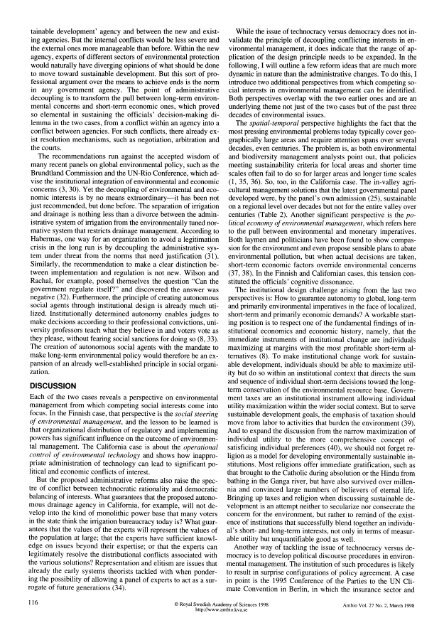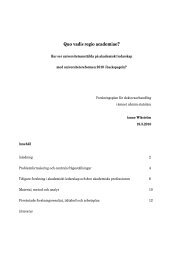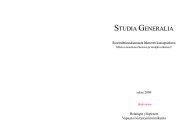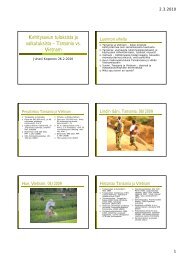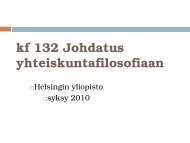tainable development' agency and between the new and existingagencies. But the internal conflicts would be less severe andthe external ones more manageable than before. Within the newagency, experts of different sectors of environmental protectionwould naturally have diverging opinions of what should be doneto move toward sustainable development. But this sort of professionalargument over the means to achieve ends is the normin any government agency. The point of administrativedecoupling is to transform the pull between long-term environmentalconcerns and short-term economic ones, which provedso elemental in sustaining the officials' decision-making dilemmain the two cases, from a conflict within an agency into aconflict between agencies. For such conflicts, there already existresolution mechanisms, such as negotiation, arbitration andthe courts.The recommendations run against the accepted wisdom ofmany recent panels on global environmental policy, such as theBrundtland Commission and the UN-Rio Conference, which ad-vise the institutional integration of environmental and economicconcerns (3, 30). Yet the decoupling of environmental and economicinterests is by no means extraordinary-it has been notjust recommended, but done before. The separation of irrigationand drainage is nothing less than a divorce between the admin-istrative system of irrigation from the environmentally tuned normativesystem that restricts drainage management. According toHabermas, one way for an organization to avoid a legitimationcrisis in the long run is by decoupling the administrative systemunder threat from the norms that need justification (31).Similarly, the recommendation to make a clear distinction betweenimplementation and regulation is not new. Wilson andRachal, for example, posed themselves the question "Can thegovernment regulate itself?" and discovered the answer wasnegative (32). Furthermore, the principle of creating autonomoussocial agents through institutional design is already much utilized.Institutionally determined autonomy enables judges tomake decisions according to their professional convictions, universityprofessors teach what they believe in and voters vote asthey please, without fearing social sanctions for doing so (8, 33).The creation of autonomous social agents with the mandate tomake long-term environmental policy would therefore be an expansionof an already well-established principle in social organization.DISCUSSIONEach of the two cases reveals a perspective on environmentalmanagement from which competing social interests come intofocus. In the Finnish case, that perspective is the social steeringof environmental management, and the lesson to be learned isthat organizational distribution of regulatory and implementingpowers has significant influence on the outcome of environmentalmanagement. The California case is about the operationalcontrol of environmental technology and shows how ina<strong>pp</strong>ropriateadministration of technology can lead to significant politicaland economic conflicts of interest.But the proposed administrative reforms also raise the spectreof conflict between technocratic rationality and democraticbalancing of interests. What guarantees that the proposed autonomousdrainage agency in California, for example, will not developinto the kind of monolithic power base that many votersin the state think the irrigation bureaucracy today is? What guaranteesthat the values of the experts will represent the values ofthe population at large; that the experts have sufficient knowledgeon issues beyond their expertise; or that the experts canlegitimately resolve the distributional conflicts associated withthe various solutions? Representation and elitism are issues thatalready the early systems theorists tackled with when ponderingthe possibility of allowing a panel of experts to act as a surrogateof future generations (34).While the issue of technocracy versus democracy does not invalidatethe principle of decoupling conflicting interests in environmentalmanagement, it does indicate that the range of a<strong>pp</strong>licationof the design principle needs to be expanded. In thefollowing, I will outline a few reform ideas that are much moredynamic in nature than the administrative changes. To do this, Iintroduce two additional perspectives from which competing socialinterests in environmental management can be identified.Both perspectives overlap with the two earlier ones and are anunderlying theme not just of the two cases but of the past threedecades of environmental issues.The spatial-temporal perspective highlights the fact that themost pressing environmental problems today typically cover geographicallylarge areas and require attention spans over severaldecades, even centuries. The problem is, as both environmentaland biodiversity management analysts point out, that policiesmeeting sustainability criteria for local areas and shorter timescales often fail to do so for larger areas and longer time scales(1, 35, 36). So, too, in the California case. The in-valley agri-cultural management solutions that the latest governmental paneldeveloped were, by the panel's own admission (25), sustainableon a regional level over decades but not for the entire valley overcenturies (Table 2). Another significant perspective is the politicaleconomy of environmental management, which refers hereto the pull between environmental and monetary imperatives.Both laymen and politicians have been found to show compas-sion for the environment and even propose sensible plans to abateenvironmental pollution, but when actual decisions are taken,short-term economic factors override environmental concerns(37, 38). In the Finnish and Californian cases, this tension constitutedthe officials' cognitive dissonance.The institutional design challenge arising from the last twoperspectives is: How to guarantee autonomy to global, long-termand primarily environmental imperatives in the face of localized,short-term and primarily economic demands? A workable startingposition is to respect one of the fundamental findings of institutionaleconomics and economic history, namely, that theimmediate instruments of institutional change are individualsmaximizing at margins with the most profitable short-term alternatives(8). To make institutional change work for sustainabledevelopment, individuals should be able to maximize utilitybut do so within an institutional context that directs the sumand sequence of individual short-term decisions toward the longtermconservation of the environmental resource base. Governmenttaxes are an institutional instrument allowing individualutility maximization within the wider social context. But to servesustainable development goals, the emphasis of taxation shouldmove from labor to activities that burden the environment (39).And to expand the discussion from the narrow maximization ofindividual utility to the more comprehensive concept ofsatisficing individual preferences (40), we should not forget re-ligion as a model for developing environmentally sustainable institutions.Most religions offer immediate gratification, such asthat brought to the Catholic during absolution or the Hindu frombathing in the Ganga river, but have also survived over millenniaand convinced large numbers of believers of eternal life.Bringing up taxes and religion when discussing sustainable developmentis an attempt neither to secularize nor consecrate theconcern for the environment, but rather to remind of the existenceof institutions that successfully blend together an individual'sshort- and long-term interests, not only in terms of measurableutility but unquantifiable good as well.Another way of tackling the issue of technocracy versus de-mocracy is to develop political discourse procedures in environmentalmanagement. The institution of such procedures is likelyto result in surprise configurations of policy agreement. A casein point is the 1995 Conference of the Parties to the UN ClimateConvention in Berlin, in which the insurance sector and116 ? Royal Swedish Academy of Sciences 1998 <strong>Ambio</strong> <strong>Vol</strong>. <strong>27</strong> <strong>No</strong>. 2, March 1998http://www.ambio.kva.se
environmental groups, despite fundamental differences in themental models they used to rationalize global warming, wereable to join forces in lobbying industry to reduce its greenhousegas emissions (41). Land-use planning and environmental impactassessment are two existing procedures that could potentiallybe developed into institutionalized forms of interaction betweendiverse interest groups in environmental management.Both contain procedures for public participation, such as publichearings and commenting periods. To transform impact assessmentinto a democratic decision-making forum within the regimeof environmental management would, however, require a shiftfrom today's project-based assessment to a permanent assessmentbody with elected members. This would obviously entailcareful consideration of mandates between the new body andother elected bodies in the region. The guiding principle of thenew body would nonetheless remain clear; i.e. deciding on issuesof sustainable development and long-term environmentalmanagement.EPILOGUEWhen my co-workers and I presented our recommendations tothe California irrigation agencies, we received generally su<strong>pp</strong>ortivecomments. However, when we a<strong>pp</strong>lied for what we thoughtwas an agreed-upon renewal of research funding to focus onmore specific data collection, it was denied. We were told thatpriorities had shifted, that the agency was not primarily inter-ested in action, that further institutional work was to focus onlaw, and that there simply was no more funding for work suchas ours. In short, we were tra<strong>pp</strong>ed by the same dilemma that keptthe irrigation bureaucracy shifting the drainage agenda the momentthe current one called for policy action.Throughout the Finnish study officials at the Ministry of theEnvironment, which was the initiator and su<strong>pp</strong>orter of the study,enthusiastically talked about rapid publication of the final reportcombined with a public seminar. Yet six months after the submissionof the final manuscript the Ministry still had not publishedthe report. According to Ministry officials, the diagnosiswas misconstrued, because Ekokem's administration was an exampleof the way matters had always been dealt with in Finlandand administrative decoupling therefore had no practical relevanceto the Ministry's long-term environmnental strategy. Aftermuch persuasion, the report was published-without a publicseminar. Once again, the institutional recommendations becameprisoners of their own logic.The silver lining in all this has three layers. (i) A verified hypothesisis always gratifying to a researcher, even if it meansdiscontinuation of further research. (ii) Since institutional changeis known to be slow, there is reason to be optimistic that at somepoint in the future the recommendations will resonate with themental models of the policy makers better than they did at thetime of the studies. (iii) The very inertia of all institutions bodeswell for the endurance of environmentally sustainable institutionsonce they do emerge.References and <strong>No</strong>tes1. Groombridge, B. (ed.). 1992. Global Biodiversity: Status of the Earth's Living Resources.Compiled by World Conservation Monitoring Centre. Chapman & Hall, London.2. Redclift, M. 1992. Sustainable Development: Exploring the Contradictions. Routledge,London.3. World Commission on Environment and Development. 1990. Our Common Future.Oxford University Press. Oxford.4. <strong>No</strong>rgaard, R.B. 1994. Development Betrayed: The End of Progress and aCoevolutionary Revisioning of the Future. Routledge, London.5. Kurki-Suonio, I. and Heikkila, M. (eds). 1994. Kestdvdn kehityksen edellytyksetSuomessa: Imatran Voima Oy:n 60-vuotisjuhlajulkaisu (Preconditions of SustainableDevelopment in Finland). Tammi, Helsinki. (In Finnish).6. Hukkinen, J. 1990. Unplugging Drainage: Toward Sociotechnical Redesign of SanJoaquin Valley's Agricultural Drainage Management. Dissertation submitted in partialsatisfaction of the requirements for the degree of Doctor of Philosophy in CivilEngineering. University of Califomia, Berkeley.7. Douglas, M. and Wildavsky, A. 1983. Risk and Culture: An Essay on the Selection ofTechnical and Environmental Dangers. University of Califomia Press, Berkeley.8. <strong>No</strong>rth, D. 1992. Institutions, Institutional Change and Economic Performance. CambridgeUniversity Press, Cambridge.9. For an in-depth analysis of institutional questions in smaller scale environmental managementprojects, see Ostrom, E. 1994. Governing the Commons: The Evolution of Institutionsfor Collective Action. Cambridge University Press, Cambridge.10. Festinger, L. 1962. A Theory of Cognitive Dissonance. Stanford University Press,Stanford.11. Assmuth, T., Poutanen, H., Strandberg, T., Melanen, M., Penttila, S. and Kalevi, K.1990. Environmental Impacts of Hazardous Wastes in Landfills. Series A:67. NationalBoard of Waters and the Environment, Helsinki. (In Finnish, summary in English).12. Vahvelainen, S. and Isaksson, K.-E. 1992. Industrial waste. Environment Series 1992:1.Statistics Finland, Helsinki, p. 102. (In Finnish, summary in English).13. Hukkinen, J. 1995. Corporatism as an impediment to ecological sustenance: The caseof Finnish waste management. Ecol. Econ. 15, 59-75.14. Hukkinen, J. 1995. Long-term environmental policy under corporatist institutions. Eur.Environ. 5, 98-105.15. More on analysis of mental models, see a 1992 special issue of J. Mgmt Stud. 29, 261-389.16. Pearl, J. 1988. Probabilistic Reasoning in Intelligent Systems: Networks of PlausibleInference. Morgan Kaufmann Publishers, San Mateo.17. Wilson, R. J. 1974. Introduction to Graph Theory. Academic Press, New York.18. Koivukoski, E. 1992. Ongelmajdtehuoltoa 10 vuotta (10 years of hazardous waste management).Mainos Wallin, Riihimaki. (In Finnish).19. Agricultural Drainage and Salt Management in the San Joaquin Valley, Final Report.1979. San Joaquin Valley Interagency Drainage Program, Fresno.20. Developing Options, An Overview of Efforts to Solve Agricultural Drainage and Drainage-RelatedProblems in the San Joaquin Valley. 1987. San Joaquin Valley DrainageProgram, Sacramento.21. Comprehensive Plan for Water Resources Development: Central Valley Basin, California.1945. Project Planning Report <strong>No</strong>. 2-4.0-3, <strong>No</strong>vember, US Bureau of Reclamation,Washington, DC.22. The California Water Plan. 1957. Bulletin <strong>No</strong>. 3, Califomia Department of Water Resources,Sacramento.23. San Joaquin Valley Drainage Advisory Group. 1969. Final Report. Califomia Departmentof Water Resources, Fresno.24. Agricultural Drainage and Salt Management in the San Joaquin Valley, Final Report.1979. San Joaquin Valley Interagency Drainage Program, Fresno.25. A Management Plan for Agricultural Subsurface Drainage and Related Problems onthe Westside San Joaquin Valley. 1990. San Joaquin Valley Drainage Program,Sacramento.26. Hukkinen, J. 1993. Bayesian analysis of agricultural drainage problems in Califomia'sSan Joaquin valley. J. Environ. Mgmt 37, 183-200.<strong>27</strong>. Hukkinen, J., Roe, E. and Rochlin, G. 1990. A salt on the land: A narrative analysis ofthe controversy over irrigation-related salinity and toxicity in California's San Joaquinvalley. Policy Sci. 23, 307-329.28. Preliminary Planning Alternatives for Solving Agricultural Drainage and Drainage-Related Problems in the San Joaquin Valley. 1989. San Joaquin Valley Drainage Program,Sacramento.28. Hukkinen, J. 1991. Sociotechnical analysis of irrigation drainage in Central California.J. Water Res. Planning Mgmt, ASCE <strong>117</strong>, 217-234.30. Robinson, N.A. (ed.). 1993. Agenda 21: Earth's Action Plan. IUCN environmentalpolicy & law paper no. <strong>27</strong>. Oceana, New York.31. Habermas, J. 1975. Legitimation Crisis. Trans. T. McCarthy. Beacon Press, Boston.32. Wilson, J.Q. and Rachal, P. 1977. Can the government regulate itself? The Public Interest,<strong>No</strong>. 46, Winter, 3-14.33. Scott, W.R. 1987. Organizations: Rational, Natural, and Open Systems, 2nd Ed.Prentice-Hall, Englewood Cliffs.34. Churchman, C.W. 1983. The Systems A<strong>pp</strong>roach, Revised and Updated. Dell, New York.35. Dovers, S.R. 1995. A framework for scaling and framing policy problems insustainability. Ecol. Econ. 12, 93-106.36. Wolf, S.A. and Allen, T.F.H. 1995. Recasting alternative agriculture as a managementmodel: The value of adept scaling. Ecol. Econ. 12, 5-12.37. Opschoor, H. and van der Straaten, J. 1993. Sustainable development: An institutionala<strong>pp</strong>roach. Ecol. Econ. 7, 203-222.38. Uusitalo, L. 1991. Suomalaiset ja ymparisto. Tutkimus taloudellisen kayttaytymisenrationaalisuudesta (Finns and the environment. A study of the rationality of economicbehavior). Acta Academiae Oeconomicae Helsingiensis, A:49. The Helsinki School ofEconomics and Business Administration, Helsinki. (In Finnish).39. Constanza, R., Daly, H., Hawken, P. and Woodwell, J. 1995. <strong>No</strong>n-partisan ecologicaltax reform: A win-win proposal that is economically efficient, socially equitable, andecologically sustainable. Int. Soc. Ecol. Econ. Newsl. 6, 3, 8.40. March, J.G and Simon, H.A. 1994. Organizations, Seconcl Edition. Blackwell, Cambridge.41. The Economist. 1995. Climate change: Smoke. 8 April, 58.42. The article is based on a paper presented at the International Workshop on BiodiversityManagement: Theoretical and Methodological Problems at the Satakunta EnvironmentalResearch Centre in Pori on 23-24 August 1995. I thank all the participants of theworkshop and Chuck Dyke, Yrjo Haila, and two anonymous reviewers in particularfor valuable comments on earlier versions of the article. Some of the arguments a<strong>pp</strong>earin a different form in my forthcoming book Institutions in Environmental Management.Routledge Ltd, London.43. First submitted 25 January 1996. Accepted for publicationi after revision 4 February1997.Janne Hukkinen is a professor and director of the ArcticCentre at the University of Lapland. He received his PhD inenvironmental engineering and policy at the University ofCalifornia, Berkeley, in 1990. He has been a research fellowat the American Association for the Advancement ofScience, senior researcher at the Technical ResearchCentre of Finland and associate professor of environmentalmanagement at Maastricht School of Management.His address: Arctic Centre, University of Lapland,PO Box 122, FIN-96101 Rovaniemi, Finland.e-mail: janne.hukkinen@levi.urova.fi<strong>Ambio</strong> <strong>Vol</strong>. <strong>27</strong>, <strong>No</strong>. 2 March 1998 ? Royal Swedish Academy of Sciences 1998 <strong>117</strong>http://www.ambio.kva.se


